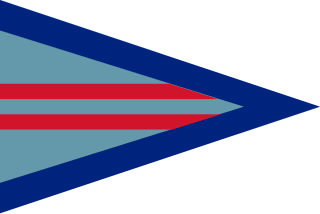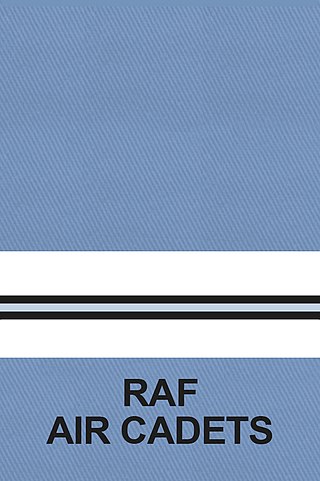Lieutenant Commander is a commissioned officer rank in many navies. The rank is superior to a lieutenant and subordinate to a commander. The corresponding rank in most armies and air forces is major, and in the Royal Air Force and other Commonwealth air forces is squadron leader.
Commander is a common naval officer rank as well as a job title in many armies. Commander is also used as a rank or title in other formal organizations, including several police forces. In several countries this naval rank is termed frigate captain.
Flying officer is a junior commissioned rank in the Royal Air Force (RAF) and the air forces of many countries which have historical British influence. It is also sometimes used as the English translation of an equivalent rank in countries which have a non-English air force-specific rank structure. In these cases a flying officer usually ranks above pilot officer and immediately below flight lieutenant.

Squadron leader is a commissioned rank in the Royal Air Force and the air forces of many countries which have historical British influence. It is also sometimes used as the English translation of an equivalent rank in countries which have a non-English air force-specific rank structure.

Wing commander is a senior commissioned rank in the British Royal Air Force and air forces of many countries which have historical British influence, including many Commonwealth countries but not including Canada and South Africa. It is sometimes used as the English translation of an equivalent rank in countries which have a non-English air force-specific rank structure. It ranks immediately above squadron leader and immediately below group captain.

Group captain is a senior commissioned rank in the Royal Air Force, where it originated, as well as the air forces of many countries that have historical British influence. It is sometimes used as the English translation of an equivalent rank in countries which have a non-British air force-specific rank structure. Group captain has a NATO rank code of OF-5, meaning that it ranks above wing commander and immediately below air commodore, and is the equivalent of the rank of captain in the navy and of the rank of colonel in other services.
Flight lieutenant is a junior commissioned rank in air forces that use the Royal Air Force (RAF) system of ranks, especially in Commonwealth countries. It has a NATO rank code of OF-2. Flight lieutenant is abbreviated as Flt Lt in the Indian Air Force (IAF) and RAF, and as FLTLT in the Pakistan Air Force (PAF), Royal Australian Air Force (RAAF) and Royal New Zealand Air Force (RNZAF) and has sometimes also been abbreviated as F/L in many services; it has never been correctly abbreviated as "lieutenant". A flight lieutenant ranks above flying officer and below a squadron leader and is sometimes used as an English language translation of a similar rank in non-English-speaking countries.
Pilot officer is the lowest commissioned rank in the Royal Air Force and the air forces of many other Commonwealth countries. It ranks immediately below flying officer.
Officer Cadet is a rank held by military cadets during their training to become commissioned officers. In the United Kingdom, the rank is also used by members of University Royal Naval Units, University Officer Training Corps and University Air Squadron; however, these are not trainee officers with many not choosing a career in the armed forces.
Listed in the table below are the insignia—emblems of authority—of the British Army. Badges for field officers were introduced in 1810 and the insignia was moved to the epaulettes in 1880. On ceremonial or parade uniforms these ranks continue to be worn on the epaulettes, either as cloth slides or as metal clips, although on the modern 'working dress' they are usually worn as a cloth slide on the chest. Although these insignia apply across the British Army there is variation in the precise design and colours used and it can take some time to become familiar with them all.

Acting pilot officer is the lowest commissioned grade in the Royal Air Force. Acting pilot officer is not an actual military rank, therefore acting pilot officers are regraded to pilot officer instead of receiving a promotion. Unlike other RAF ranks which officers may hold in an acting capacity, acting pilot officer is maintained as a separate grade. The grade normally denotes an officer who has recently been commissioned and joined as a non-graduate direct entrant.
The officer ranks of the Royal Air Force, as they are today, were introduced in 1919. Prior to that Army ranks were used.
Major (Maj) is a military rank which is used by both the British Army and Royal Marines. The rank is superior to captain and subordinate to lieutenant colonel. The insignia for a major is a crown. The equivalent rank in the Royal Navy is lieutenant commander, and squadron leader in the Royal Air Force.

These are the official Royal Navy Officer ranks ordered by rank. These ranks are part of the NATO/United Kingdom ranks, including modern and past. Past insignia is in italic.
Commander (Cdr) is a senior officer rank of the Royal Navy of the United Kingdom. It is immediately junior to captain and immediately senior to the rank of lieutenant commander. Officers holding the junior rank of lieutenant commander are not considered to be commanders.
In the Royal Canadian Navy, the rank of lieutenant-commander (LCdr) is the naval rank equal to major in the army or air force and is the first rank of senior officer. Lieutenant-commanders are senior to lieutenants (N) and to army and air force captains, and are junior to commanders and lieutenant colonels.

A warrant officer (WO) in the British Armed Forces is a member of the highest-ranking group of non-commissioned ranks, holding the King's Warrant, which is signed by the Secretary of State for Defence.
Lieutenant (abbreviated Lt, LT (U.S.), LT(USN), Lieut and LEUT, depending on nation) is a commissioned officer rank in many English-speaking nations' navies and coast guards. It is typically the most senior of junior officer ranks. In most navies, the rank's insignia may consist of two medium gold braid stripes, the uppermost stripe featuring an executive curl in many Commonwealth of Nations; or three stripes of equal or unequal width.
The following table displays the ranks of the Community Cadet Forces, the Combined Cadet Force, the Volunteer Cadet Corps, and the Girls Venture Corps Air Cadets. This table is based on equivalent Rank Structures within the Cadet Forces as detailed in regulations of the SCC, RMC, and the Air Cadets.






